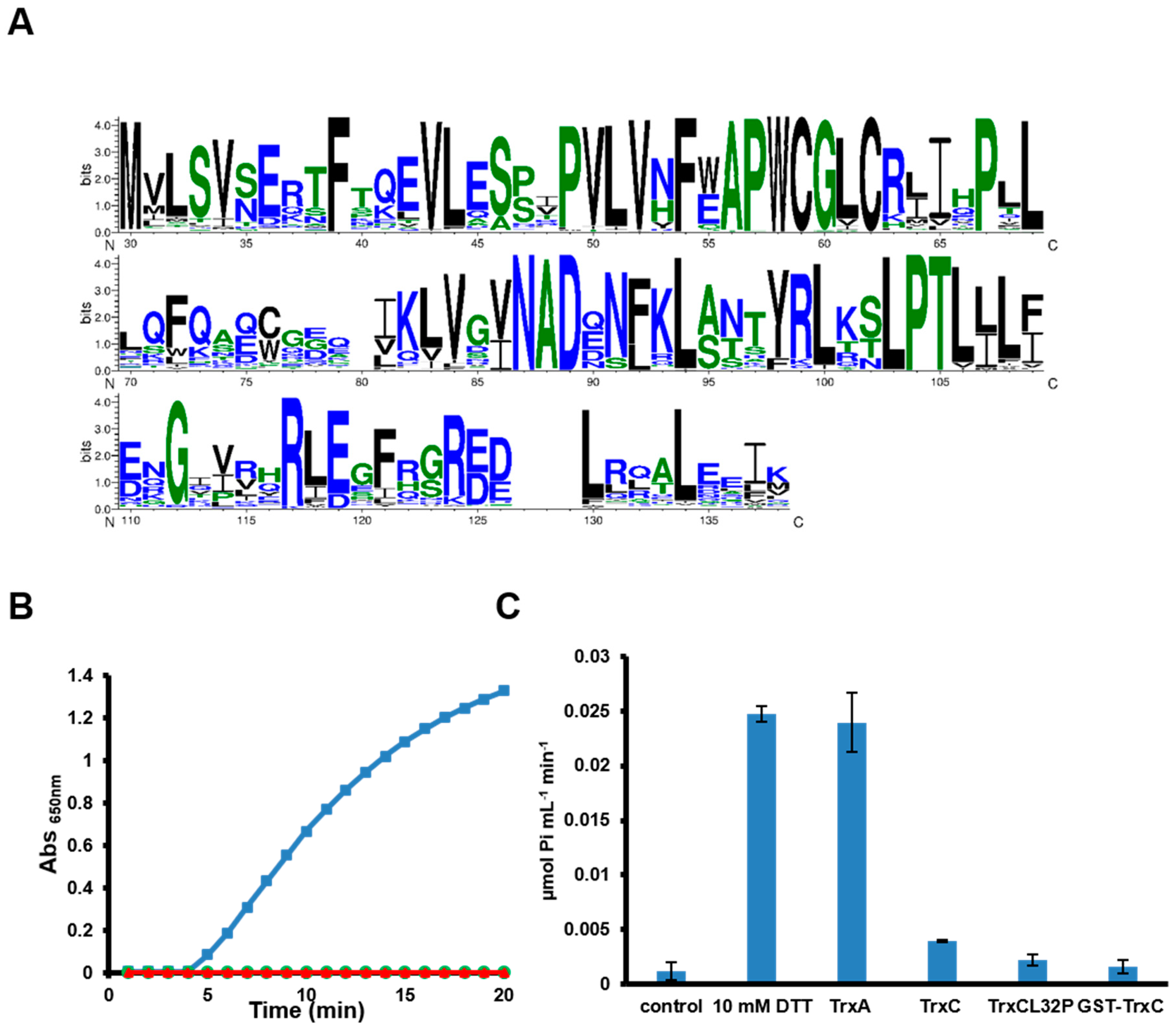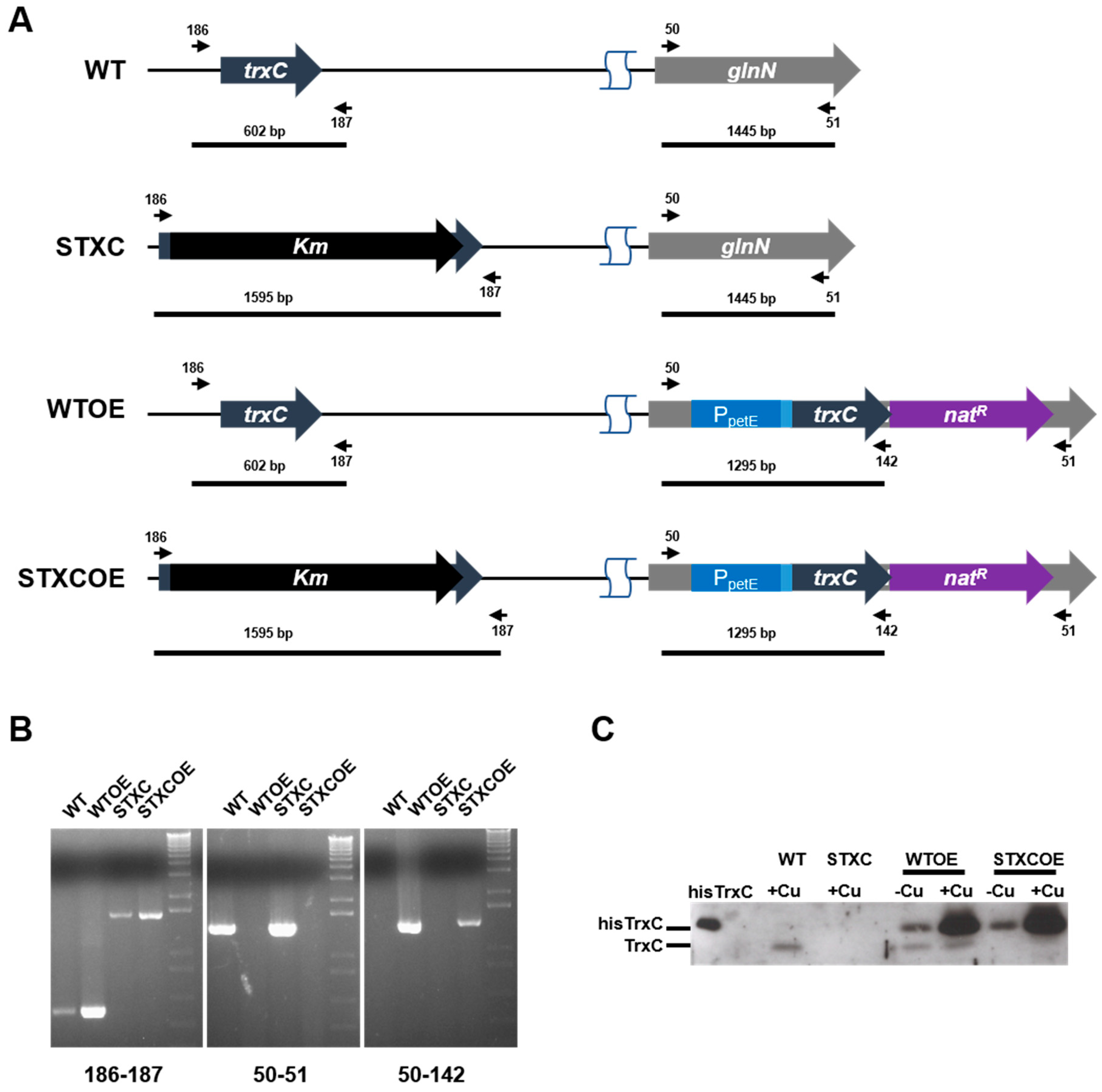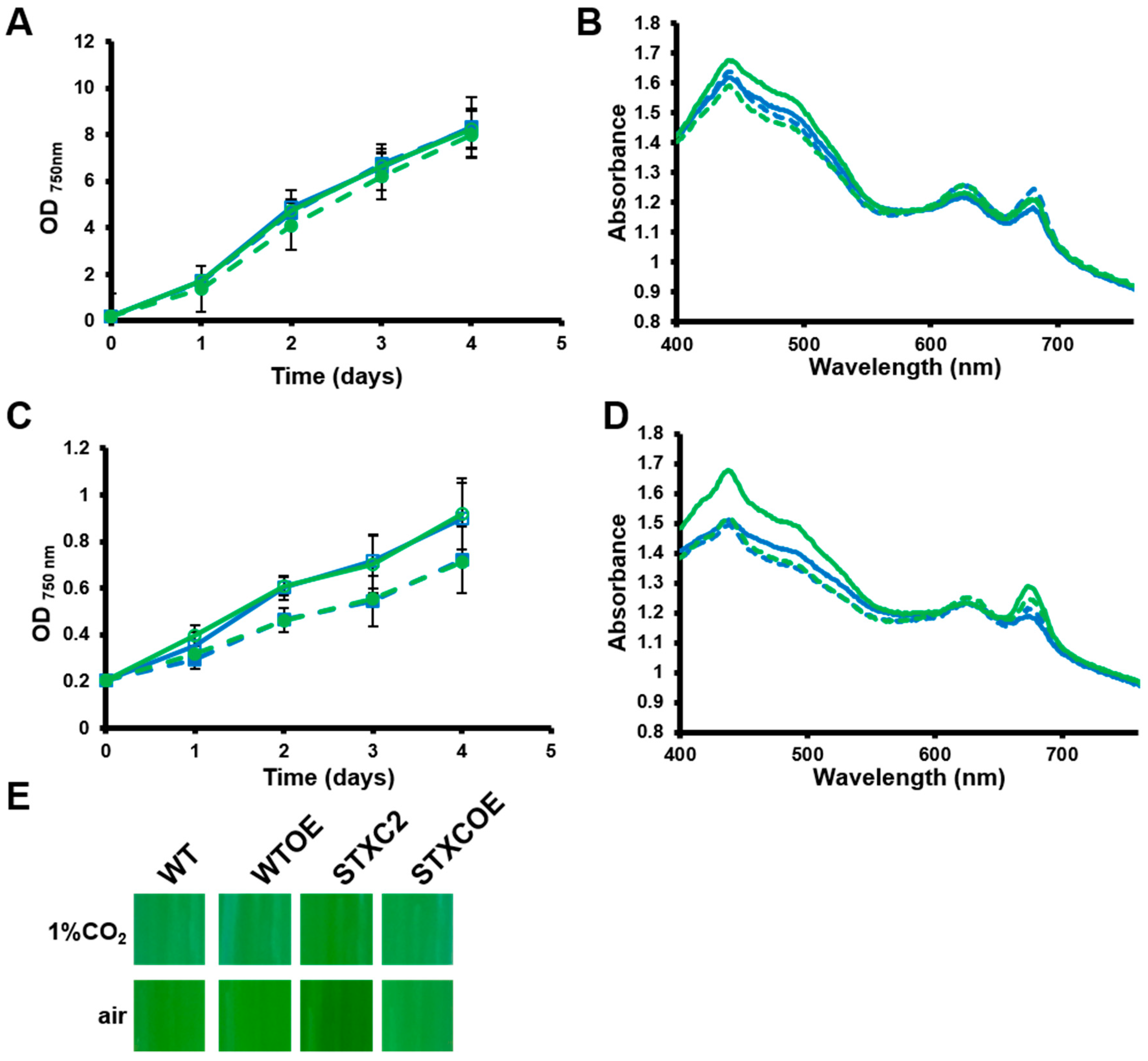Characterization of TrxC, an Atypical Thioredoxin Exclusively Present in Cyanobacteria
Abstract
1. Introduction
2. Materials and Methods
2.1. Strains and Culture Conditions
2.2. Western Blotting
2.3. Cloning and Purification of TrxC
2.4. Mutant Construction
2.5. FBPase Activation Assay
2.6. Insulin Reduction Assay
2.7. PAM
2.8. Oxygen Evolution
3. Results
3.1. TrxC Is an Atypical Thioredoxin Exclusively Found in Cyanobacteria
3.2. TrxC Mutant and Overexpression Strains Characterization
3.3. Growth of TrxC Mutant Strains under Low CO2 Conditions
3.4. Photosynthetic Characterization of TrxC Mutant Strains
4. Discussion
5. Conclusions
Supplementary Materials
Author Contributions
Funding
Acknowledgments
Conflicts of Interest
References
- Collet, J.-F.; Messens, J. Structure, Function, and Mechanism of Thioredoxin Proteins. Antioxid. Redox Signal. 2010, 13, 1205–1216. [Google Scholar] [CrossRef] [PubMed]
- Balsera, M.; Uberegui, E.; Schürmann, P.; Buchanan, B.B. Evolutionary development of redox regulation in chloroplasts. Antioxid. Redox Signal. 2014, 21, 1327–1355. [Google Scholar] [CrossRef] [PubMed]
- Buchanan, B.B. The Path to Thioredoxin and Redox Regulation Beyond Chloroplasts. Plant Cell Physiol. 2017, 58, 1826–1832. [Google Scholar] [CrossRef] [PubMed]
- Meyer, Y.; Belin, C.; Delorme-Hinoux, V.; Reichheld, J.-P.; Riondet, C. Thioredoxin and Glutaredoxin Systems in Plants: Molecular Mechanisms, Crosstalks, and Functional Significance. Antioxid. Redox Signal. 2012, 17, 1124–1160. [Google Scholar] [CrossRef] [PubMed]
- Serrato, A.J.; Fernández-Trijueque, J.; Barajas-López, J.-D.; Chueca, A.; Sahrawy, M. Plastid thioredoxins: A “one-for-all” redox-signaling system in plants. Front. Plant Sci. 2013, 4, 463. [Google Scholar] [CrossRef] [PubMed]
- Florencio, F.J.; Pérez-Pérez, M.E.; López-Maury, L.; Mata-Cabana, A.; Lindahl, M. The diversity and complexity of the cyanobacterial thioredoxin systems. Photosynth. Res. 2006, 89, 157–171. [Google Scholar] [CrossRef] [PubMed]
- Sánchez-Riego, A.M.; Mata-Cabana, A.; Galmozzi, C.V.; Florencio, F.J. NADPH-Thioredoxin Reductase C Mediates the Response to Oxidative Stress and Thermotolerance in the Cyanobacterium Anabaena sp. PCC7120. Front. Microbiol. 2016, 7, 1283. [Google Scholar] [CrossRef] [PubMed]
- Mihara, S.; Yoshida, K.; Higo, A.; Hisabori, T. Functional Significance of NADPH-Thioredoxin Reductase C in the Antioxidant Defense System of Cyanobacterium Anabaena sp. PCC 7120. Plant Cell Physiol. 2017, 58, 86–94. [Google Scholar] [CrossRef] [PubMed]
- Pascual, M.B.; Mata-Cabana, A.; Florencio, F.J.; Lindahl, M.; Cejudo, F.J. A comparative analysis of the NADPH thioredoxin reductase C-2-Cys peroxiredoxin system from plants and cyanobacteria. Plant Physiol. 2011, 155, 1806–1816. [Google Scholar] [CrossRef] [PubMed]
- Buey, R.M.; Galindo-Trigo, S.; López-Maury, L.; Velázquez-Campoy, A.; Revuelta, J.L.; Florencio, F.J.; de Pereda, J.M.; Schürmann, P.; Buchanan, B.B.; Balsera, M. A New Member of the Thioredoxin Reductase Family from Early Oxygenic Photosynthetic Organisms. Mol. Plant 2017, 10, 212–215. [Google Scholar] [CrossRef] [PubMed]
- Buey, R.M.; Arellano, J.B.; López-Maury, L.; Galindo-Trigo, S.; Velázquez-Campoy, A.; Revuelta, J.L.; de Pereda, J.M.; Florencio, F.J.; Schürmann, P.; Buchanan, B.B.; et al. Unprecedented pathway of reducing equivalents in a diflavin-linked disulfide oxidoreductase. Proc. Natl. Acad. Sci. USA 2017, 114, 12725–12730. [Google Scholar] [CrossRef] [PubMed]
- Lindahl, M.; Florencio, F.J. Systematic screening of reactive cysteine proteomes. Proteomics 2004, 4, 448–450. [Google Scholar] [CrossRef] [PubMed]
- Lindahl, M.; Florencio, F.J. Thioredoxin-linked processes in cyanobacteria are as numerous as in chloroplasts, but targets are different. Proc. Natl. Acad. Sci. USA 2003, 100, 16107–16112. [Google Scholar] [CrossRef] [PubMed]
- Mata-Cabana, A.; Florencio, F.J.; Lindahl, M. Membrane proteins from the cyanobacterium Synechocystis sp. PCC 6803 interacting with thioredoxin. Proteomics 2007, 7, 3953–3963. [Google Scholar] [CrossRef] [PubMed]
- Pérez-Pérez, M.E.; Florencio, F.J.; Lindahl, M. Selecting thioredoxins for disulphide proteomics: Target proteomes of three thioredoxins from the cyanobacterium Synechocystis sp. PCC 6803. Proteomics 2006, 6, S186–S195. [Google Scholar] [CrossRef] [PubMed]
- Motohashi, K.; Romano, P.G.N.; Hisabori, T. Identification of Thioredoxin Targeted Proteins Using Thioredoxin Single-Cysteine Mutant-Immobilized Resin. In Plant Signal Transduction; Methods in Molecular Biology; Humana Press: Totowa, NJ, USA, 2009; Volume 479, pp. 117–131. [Google Scholar]
- Nomata, J.; Maeda, M.; Isu, A.; Inoue, K.; Hisabori, T. Involvement of thioredoxin on the scaffold activity of NifU in heterocyst cells of the diazotrophic cyanobacterium Anabaena sp. strain PCC 7120. J. Biochem. 2015, 158, 253–261. [Google Scholar] [CrossRef] [PubMed]
- Navarro, F.; Florencio, F.J. The cyanobacterial thioredoxin gene is required for both photoautotrophic and heterotrophic growth. Plant Physiol. 1996, 111, 1067–1075. [Google Scholar] [CrossRef] [PubMed]
- Muller, E.G.; Buchanan, B.B. Thioredoxin is essential for photosynthetic growth. The thioredoxin m gene of Anacystis nidulans. J. Biol. Chem. 1989, 264, 4008–4014. [Google Scholar] [PubMed]
- Deschoenmaeker, F.; Mihara, S.; Niwa, T.; Taguchi, H.; Wakabayashi, K.; Hisabori, T.; Ikeda, K.; Niwa, T.; Taguchi, H.; Hisabori, T. The absence of thioredoxin m1 and thioredoxin C in Anabaena sp. PCC 7120 leads to oxidative stress. Plant Cell Physiol. 2018. [Google Scholar] [CrossRef] [PubMed]
- Mihara, S.; Wakao, H.; Yoshida, K.; Higo, A.; Sugiura, K.; Tsuchiya, A.; Nomata, J.; Wakabayashi, K.-I.; Hisabori, T. Thioredoxin regulates G6PDH activity by changing redox states of OpcA in the nitrogen-fixing cyanobacterium Anabaena sp. PCC 7120. Biochem. J. 2018, 475, 1091–1105. [Google Scholar] [CrossRef] [PubMed]
- Geigenberger, P.; Thormählen, I.; Daloso, D.M.; Fernie, A.R. The Unprecedented Versatility of the Plant Thioredoxin System. Trends Plant Sci. 2017, 22, 249–262. [Google Scholar] [CrossRef] [PubMed]
- Pérez-Pérez, M.E.; Martín-Figueroa, E.; Florencio, F.J. Photosynthetic Regulation of the Cyanobacterium Synechocystis sp. PCC 6803 Thioredoxin System and Functional Analysis of TrxB (Trx x) and TrxQ (Trx y) Thioredoxins. Mol. Plant 2009, 2, 270–283. [Google Scholar] [CrossRef] [PubMed]
- Perez-Perez, M.E.; Mata-Cabana, A.; Sanchez-Riego, A.M.; Lindahl, M.; Florencio, F.J. A Comprehensive Analysis of the Peroxiredoxin Reduction System in the Cyanobacterium Synechocystis sp. Strain PCC 6803 Reveals that All Five Peroxiredoxins Are Thioredoxin Dependent. J. Bacteriol. 2009, 191, 7477–7489. [Google Scholar] [CrossRef] [PubMed]
- Díaz-Troya, S.; López-Maury, L.; Sánchez-Riego, A.M.; Roldán, M.; Florencio, F.J. Redox regulation of glycogen biosynthesis in the cyanobacterium Synechocystis sp. PCC 6803: Analysis of the AGP and glycogen synthases. Mol. Plant 2014, 7, 87–100. [Google Scholar] [CrossRef] [PubMed]
- Stanier, R.Y.; Deruelles, J.; Rippka, R.; Herdman, M.; Waterbury, J.B. Generic Assignments, Strain Histories and Properties of Pure Cultures of Cyanobacteria. Microbiology 1979, 111, 1–61. [Google Scholar] [CrossRef]
- Giner-Lamia, J.J.; López-Maury, L.; Florencio, F.J.; López-Maury, L.; Florencio, F.J. CopM is a novel copper-binding protein involved in copper resistance in Synechocystis sp. PCC 6803. Microbiologyopen 2015, 4, 167–185. [Google Scholar] [CrossRef] [PubMed]
- Serrato, A.J.; Romero-Puertas, M.C.; Lázaro-Payo, A.; Sahrawy, M. Regulation by S-nitrosylation of the Calvin-Benson cycle fructose-1,6-bisphosphatase in Pisum sativum. Redox Biol. 2018, 14, 409–416. [Google Scholar] [CrossRef] [PubMed]
- Gütle, D.D.; Roret, T.; Müller, S.J.; Couturier, J.; Lemaire, S.D.; Hecker, A.; Dhalleine, T.; Buchanan, B.B.; Reski, R.; Einsle, O.; et al. Chloroplast FBPase and SBPase are thioredoxin-linked enzymes with similar architecture but different evolutionary histories. Proc. Natl. Acad. Sci. USA 2016, 113, 6779–6784. [Google Scholar] [CrossRef] [PubMed]
- Susanti, D.; Wong, J.H.; Vensel, W.H.; Loganathan, U.; DeSantis, R.; Schmitz, R.A.; Balsera, M.; Buchanan, B.B.; Mukhopadhyay, B. Thioredoxin targets fundamental processes in a methane-producing archaeon, Methanocaldococcus jannaschii. Proc. Natl. Acad. Sci. USA 2014, 111, 2608–2613. [Google Scholar] [CrossRef] [PubMed]
- Ogawa, T.; Misumi, M.; Sonoike, K. Estimation of photosynthesis in cyanobacteria by pulse-amplitude modulation chlorophyll fluorescence: Problems and solutions. Photosynth. Res. 2017, 133, 63–73. [Google Scholar] [CrossRef] [PubMed]
- Couturier, J.; Jacquot, J.-P.; Rouhier, N. Evolution and diversity of glutaredoxins in photosynthetic organisms. Cell. Mol. Life Sci. 2009, 66, 2539–2557. [Google Scholar] [CrossRef] [PubMed]
- Ren, G.; Stephan, D.; Xu, Z.; Zheng, Y.; Tang, D.; Harrison, R.S.; Kurz, M.; Jarrott, R.; Shouldice, S.R.; Hiniker, A.; et al. Properties of the thioredoxin fold superfamily are modulated by a single amino acid residue. J. Biol. Chem. 2009, 284, 10150–10159. [Google Scholar] [CrossRef] [PubMed]
- Roderer, D.J.A.; Schärer, M.A.; Rubini, M.; Glockshuber, R. Acceleration of protein folding by four orders of magnitude through a single amino acid substitution. Sci. Rep. 2015, 5, 11840. [Google Scholar] [CrossRef] [PubMed]
- Lundström, J.; Krause, G.; Holmgren, A. A Pro to His mutation in active site of thioredoxin increases its disulfide-isomerase activity 10-fold. New refolding systems for reduced or randomly oxidized ribonuclease. J. Biol. Chem. 1992, 267, 9047–9052. [Google Scholar] [PubMed]
- Krause, G.; Lundström, J.; Barea, J.L.; Pueyo de la Cuesta, C.; Holmgren, A. Mimicking the active site of protein disulfide-isomerase by substitution of proline 34 in Escherichia coli thioredoxin. J. Biol. Chem. 1991, 266, 9494–9500. [Google Scholar] [PubMed]
- Roos, G.; Garcia-Pino, A.; Van belle, K.; Brosens, E.; Wahni, K.; Vandenbussche, G.; Wyns, L.; Loris, R.; Messens, J. The Conserved Active Site Proline Determines the Reducing Power of Staphylococcus aureus Thioredoxin. J. Mol. Biol. 2007, 368, 800–811. [Google Scholar] [CrossRef] [PubMed]
- Sharma, A.; Sharma, A.; Dixit, S.; Sharma, A. Structural insights into thioredoxin-2: A component of malaria parasite protein secretion machinery. Sci. Rep. 2011, 1, 179. [Google Scholar] [CrossRef] [PubMed]
- Yoshida, K.; Hara, A.; Sugiura, K.; Fukaya, Y.; Hisabori, T. Thioredoxin-like2/2-Cys peroxiredoxin redox cascade supports oxidative thiol modulation in chloroplasts. Proc. Natl. Acad. Sci. USA 2018. [Google Scholar] [CrossRef] [PubMed]
- Eliyahu, E.; Rog, I.; Inbal, D.; Danon, A. ACHT4-driven oxidation of APS1 attenuates starch synthesis under low light intensity in Arabidopsis plants. Proc. Natl. Acad. Sci. USA 2015, 112, 12876–12881. [Google Scholar] [CrossRef] [PubMed]
- Zakar, T.; Laczko-Dobos, H.; Toth, T.N.; Gombos, Z. Carotenoids Assist in Cyanobacterial Photosystem II Assembly and Function. Front. Plant Sci. 2016, 7, 295. [Google Scholar] [CrossRef] [PubMed]
- Allahverdiyeva, Y.; Isojärvi, J.; Zhang, P.; Aro, E.-M.; Allahverdiyeva, Y.; Isojärvi, J.; Zhang, P.; Aro, E.-M. Cyanobacterial Oxygenic Photosynthesis is Protected by Flavodiiron Proteins. Life 2015, 5, 716–743. [Google Scholar] [CrossRef] [PubMed]
- Battchikova, N.; Eisenhut, M.; Aro, E.-M. Cyanobacterial NDH-1 complexes: Novel insights and remaining puzzles. Biochim. Biophys. Acta Bioenerg. 2011, 1807, 935–944. [Google Scholar] [CrossRef] [PubMed]
- Zhao, J.; Gao, F.; Fan, D.-Y.; Chow, W.S.; Ma, W. NDH-1 Is Important for Photosystem I Function of Synechocystis sp. Strain PCC 6803 under Environmental Stress Conditions. Front. Plant Sci. 2018, 8, 2183. [Google Scholar] [CrossRef] [PubMed]
- Ogawa, T.; Harada, T.; Ozaki, H.; Sonoike, K. Disruption of the ndhF1 Gene Affects Chl Fluorescence through State Transition in the Cyanobacterium Synechocystis sp. PCC 6803, Resulting in Apparent High Efficiency of Photosynthesis. Plant Cell Physiol. 2013, 54, 1164–1171. [Google Scholar] [CrossRef] [PubMed]





| Strain | Relevant Genotype | Mutated ORFS | Source |
|---|---|---|---|
| WT | Synechocystis sp PCC 6803 | - | Lab collection |
| STXC2 | ΔtrxC::C.K1 | sll1057 | [25] |
| WTOE | glnN::PpetE:histrxC:Nat | slr0288 | This study |
| STXCOE | ΔtrxC::C.K1 glnN::PpetE:histrxC:Nat | sll1057, slr0288 | This study |
| STRAIN | F0 | Fm DCMU | Fv | Fv/Fm | Fm’ (Dark) | Fv’ (Dark) | Fv’/Fm’ (Dark) | NPQ (Dark) |
|---|---|---|---|---|---|---|---|---|
| WT | 0.363 ± 0.028 | 0.563 ± 0.033 | 0.200 | 0.356 | 0.427 ± 0.031 | 0.064 | 0.150 | 0.319 |
| WTOE | 0.424 ± 0.049 | 0.617 ± 0.043 | 0.193 | 0.313 | 0.505 ± 0.044 | 0.080 | 0.160 | 0.223 |
| STXC2 | 0.395 ± 0.066 | 0.597 ± 0.066 | 0.202 | 0.339 | 0.463 ± 0.076 | 0.069 | 0.148 | 0.288 |
| STXC2OE | 0.390 ± 0.028 | 0.601 ± 0.028 | 0.211 | 0.351 | 0.482 ± 0.027 | 0.091 | 0.190 | 0.248 |
© 2018 by the authors. Licensee MDPI, Basel, Switzerland. This article is an open access article distributed under the terms and conditions of the Creative Commons Attribution (CC BY) license (http://creativecommons.org/licenses/by/4.0/).
Share and Cite
López-Maury, L.; Heredia-Martínez, L.G.; Florencio, F.J. Characterization of TrxC, an Atypical Thioredoxin Exclusively Present in Cyanobacteria. Antioxidants 2018, 7, 164. https://doi.org/10.3390/antiox7110164
López-Maury L, Heredia-Martínez LG, Florencio FJ. Characterization of TrxC, an Atypical Thioredoxin Exclusively Present in Cyanobacteria. Antioxidants. 2018; 7(11):164. https://doi.org/10.3390/antiox7110164
Chicago/Turabian StyleLópez-Maury, Luis, Luis G. Heredia-Martínez, and Francisco J. Florencio. 2018. "Characterization of TrxC, an Atypical Thioredoxin Exclusively Present in Cyanobacteria" Antioxidants 7, no. 11: 164. https://doi.org/10.3390/antiox7110164
APA StyleLópez-Maury, L., Heredia-Martínez, L. G., & Florencio, F. J. (2018). Characterization of TrxC, an Atypical Thioredoxin Exclusively Present in Cyanobacteria. Antioxidants, 7(11), 164. https://doi.org/10.3390/antiox7110164





